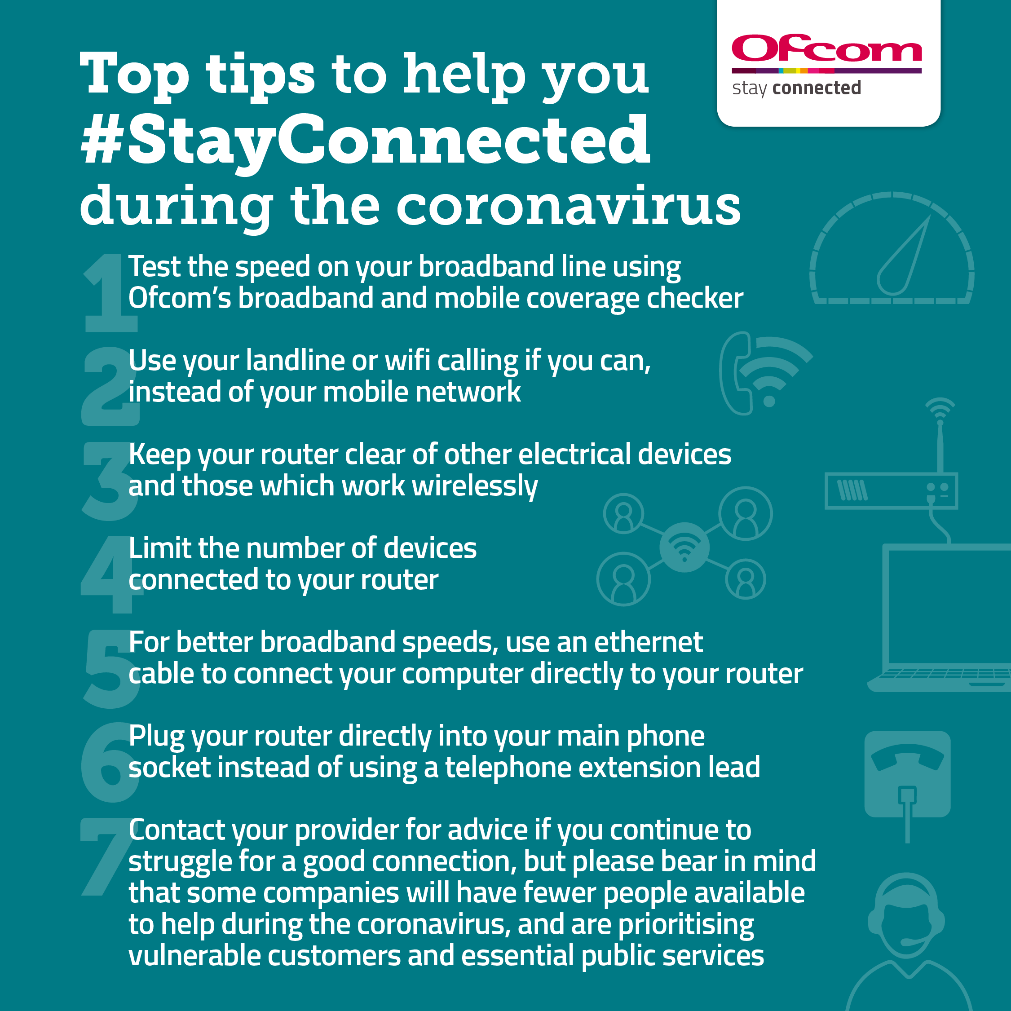13 May 2020 Average UK broadband speeds largely held up during the Covid-19 lockdown – despite rising demand from home working, online lessons and TV streaming.
Ofcom’s Home Broadband Performance Report reveals how broadband speeds changed before and after the lockdown measures came in – when there was a surge in broadband use. Download and upload speeds fell only by 2% and 1% respectively. [1]
Demands on the broadband network have been driven in part by home working and by school closures, leading to a rise in people using streaming and educational services. Some providers have reported an increase in weekday daytime traffic of between 35 and 60% since the coronavirus restrictions came in. [2]
As children and adults look for ways to entertain themselves indoors, Netflix download speeds fell by 3% in the lockdown period compared to pre-lockdown – indicating that people rushed to catch-up with their favourite shows in their free time. But data use from increased screen time was offset by Netflix reducing the streaming quality of its content.
The responsiveness (latency) of broadband networks – the delay between a connection requesting an action and that action taking place – also remained stable. The 2% increase in delay measured would have had little effect on performance for most people.
The report also reveals that broadband speeds in rural areas are catching up to those in towns and cities. The proportion of rural lines receiving at least superfast broadband (30 Mbit/s and above) during peak times continues to increase – from 44% in 2018 to 56% in 2019 – while the proportion not receiving a decent connection (10 Mbit/s and above) at peak times fell from 33% to 22%.
But broadband speeds in rural areas still lag behind those in urban areas. Urban peak-time speeds reached 75 Mbit/s, almost double the rural average of 39 Mbit/s in 2019.
Yih-Choung Teh, Ofcom’s Group Director for Strategy and Research, said : “Broadband in the UK has really been put to the test by the pandemic, so it’s encouraging that speeds have largely held up. This has helped people to keep working, learning and staying connected with friends and family.”
Top tips on helping you stay connected
Ofcom’s Stay Connected campaign includes a range of tips to help ensure people get the best out of their internet connection during the coronavirus period:

For more information, see our guides on getting the most out of your broadband and mobile services at home.
Broadband and mobile coverage revealed
Today, we have also published our Connected Nations spring update, which provides a summary of broadband availability and mobile coverage in the UK as of January 2020, before the outbreak of Covid-19 in the UK. This shows that:
- 3.5 million homes (12%) can now access full-fibre broadband, up by a fifth since September last year.
- Availability of other high-speed broadband services has continued to increase. Ultrafast broadband (speeds of 300 Mbit/s and above), is now available to 55% of UK households, compared to 53% in our last update – an increase of 700,000 homes. Superfast broadband remains available to 95% of UK households, but the total number of homes able to receive superfast broadband has increased by 300,000.
-
Around 2% of homes and businesses are unable to get a decent fixed broadband connection (offering download speeds of 10 Mbit/s and upload speeds of 1 Mbit/s). However, anyone who cannot get a decent service, now has the legal right to request one – thanks to new rules that came into force in March. The continued rollout of mobile broadband services is also helping to get more people connected.
-
Ofcom is ensuring our regulation helps support local areas as they roll out faster fibre networks – including price protections for customers. This is part of our work to support competition and investment into faster, more reliable fibre networks.
-
Mobile coverage remains largely unchanged since our December report. But since then, the UK Government and four mobile network providers have agreed to develop a shared rural network, to help improve coverage across the UK. Each company has committed to deliver good-quality 4G coverage to at least 90% of the UK over the next six years.
Email Newsletters
Sign up to receive TelecomTV's top news and videos, plus exclusive subscriber-only content direct to your inbox.



